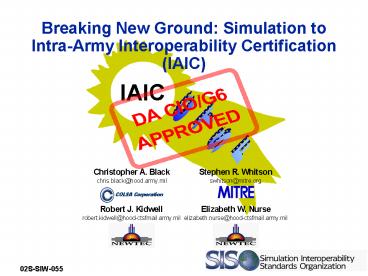Breaking New Ground: Simulation to IntraArmy Interoperability Certification IAIC - PowerPoint PPT Presentation
1 / 19
Title:
Breaking New Ground: Simulation to IntraArmy Interoperability Certification IAIC
Description:
Breaking New Ground: Simulation to Intra-Army Interoperability ... Stress Testing. Digital. Messages. Threads. Software. Blocking. Policy. 02S-SIW-055 ... – PowerPoint PPT presentation
Number of Views:88
Avg rating:3.0/5.0
Title: Breaking New Ground: Simulation to IntraArmy Interoperability Certification IAIC
1
Breaking New Ground Simulation to Intra-Army
Interoperability Certification (IAIC)
IAIC
- CTSF
2
Agenda
- Central Technical Support Facility (CTSF) IAIC
Testing Mission - Lessons Learned
- Breakthroughs
- Path Ahead
3
CTSFIntra-Army Interoperability
Mission To test all-Army C4I systems to insure
interoperability in accord-ance with Intra-Army
Inter-operability Certification Policy
as stated in the Army Acquisition Executive
Memorandum Intra-Army Interoperability
Certification, SAIS-IAA, dated 3 December
2000. Certification testing will be conducted
at the CTSF
4
CTSFIntra-Army Interoperability
- WHY CERTIFICATION?
- Evolutionary path must ensure Interoperability.
Also have backward compatibility with Legacy
Systems. - Need to know the state of system capabilities at
any moment in time. - WHY THIS FASHION?
- Economical advantage without assembling all the
systems and encounter material development
associated cost.
- WHY THE CTSF?
- Established Infrastructure.
- Equipment that represents the Army of today.
- Personnel.
- Process Established (State of the Art Process).
5
Future Candidate Systems
- A2C2S
- BCIS
- CH-47
- COMANCHE
- FAAD/AMDWS
- GBS
- GCSS-A
- GCCS
- MC4
- JTRS
- PALADIN
- PATRIOT
- Special Ops
- UH-60
- WARSIM
- OTB/OOS
- Systems Tested
- To Date
- ABRAMS
- AFATDS 99
- AMPS
- BRADLEY
- CGS
- CSSCS
- DBST
- FOS
- KIOWA WARRIOR
- LONGBOW APACHE
- MICAD
- TBMCS
- RTM
- TI MANAGER
- TUAV
- TACLANE
- C3DRIVER
- Systems Scheduled
- ADOCS
- ASAS RWS
- ASAS-L
- BPV
- EAGLE
- IMETS
- JWARN
- SIMPLE LOD
- TAIS
6
Some Lessons Learned
7
Continuity
- It is critical to ensure the participation of the
key personnel from the System Under Test (SUT)
and the CTSF Test Cell starting with the Planning
phase and working through the Execution phase.
8
TRADOC System Manager (TSM)Role
- Must be engaged from day one.
- Represents the User.
- Often not designated for simulation interfaces.
- Identifies Mission Interoperability Requirements.
- In conjunction with the Program Manager (PM)
- Approves requirements implementation.
9
Mission Interoperability Requirements
- Defined/Approved by TSM.
- Delivered to CTSF in approved format (Appendix D,
Certification Standard Operating Procedures
(SOP). - Event
- Task
- Message
- C2
- Data Radio
- Data Network
- Issues or Test Limitations
- Critical to defining test criteria and allocating
resources (Architecture, Data Collectors and
special equipment).
10
Test Environment
- Isolated from other activities.
- Configurable for specific test architecture.
- Fully instrumented.
- Dedicated Manning.
11
Certification Timing
- ABCS stability during integration and testing.
- Should be readiness driven, not date driven.
- Need alternative to IAIC for event driven
requirements.
VV
12
Stress Test
- Goal is to identify and reduce problems normally
manifested during robust exercises. - Peak message rates remain elusive.
- What is really stressed
- ABCS
- SIM/STIM
- Both
- Results to date are mixed.
- Should be a topic of the next Certification IPR.
13
Breakthroughs
- DBST
- USMTF Version Discrepancies- ABCS to TSIU and
TCSS. - F3 Position Data Error of up to 15 Minutes.
- RTM
- CMP Discrepancy Report (DR).
- F3 Time Stamp DR.
- C3DRIVER
- DAUVS/SINCGARS Limitation.
- Digital Mission Threads.
- Information Flow
- Information Exchange
14
Positive Steps
Real Time Instrumentation Verification-Feb 02
C3Drv Feb 02
CTSF Cert. SOP-Feb 02 Bi-Weekly Teleconference
RTM Jul 01
Cert. Facility-Jul 01
DBST Dec 00
Hoeper Memo
15
Certification Facility Stats
- Capabilities
- Building design allows two or more candidate
systems to be certified simultaneously without
interfering with ABCS integration testing. - Fully instrumented and simulation driven to
promote a robust test environment. - Provides an opportunity for individual systems
to integrate prior to certification. - Provides the capability for systems to do
one-stop regression testing. - Provides the capability to conduct Intra-Army
testing and participate in Joint Interoperability
testing simultaneously.
- Building Facilities
- Facility Dimensions 232.67 ft x 62 ft
- 13 Section Lab Area, 11,015 sq. ft.
- 4 Section Office Space, 3,389 sq. ft.
- Total 14,384 sq. ft.
- 2/3 size of existing TD space
- Connected at three locations at Bldgs 4, 8, 25
16
SOPPlanning and Execution Process
TSM
Mission Interoperability Requirements
Base Plan Updated every 6 months - Annex for SUT
17
Real Time Instrumentation Verification
- Real Time Aggregator (RTA) / Data Processing Unit
(DPU) - Multi-Function Data Collector (MFDC)
- High Speed LAN Tap (HSLT)
- WAN Tap
- Internet Controller (INC)
- Protocol Test Tool (PTT)
- SINCGARS radio traffic (188.220)
- VMF Test Tool (VTT)
- JVMF Message Validation
18
Path Ahead
Digital Messages Threads
Stress Testing
JSIMS-Land (L) OOS Eagle DBST
Software Blocking Policy
19
Reference Material
- 01E-SIW-073 - Whitson, S.R., Black, C.A., Diem,
J.W., Allred, N.L. Certification of U. S. Army
Simulations Interfaces with C4I Systems - SIMCI OIPT Web Site
- https//simci.army.mil/
- CTSF Web Site via the Program Office Command,
Control Communications Tactical (PEO C3T)
Knowledge Center - https//peoc3s.monmouth.army.mil/peoc3sregpub.nsf/
welcome?openpage - Certification SOP
- Base EDP































